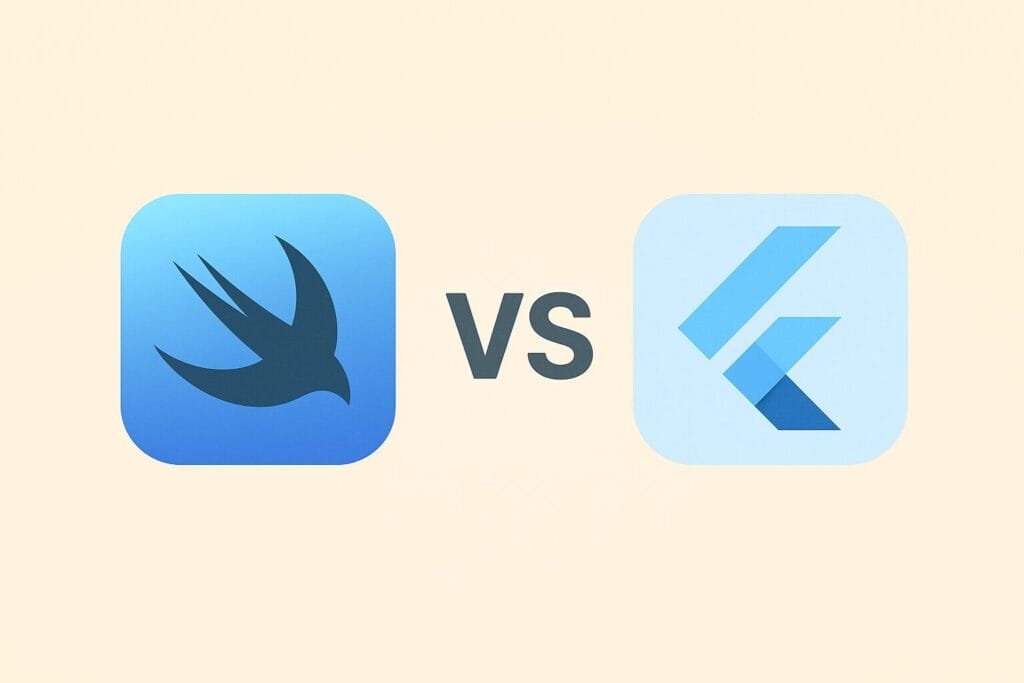When it comes to building modern iOS applications, two powerful frameworks stand out — SwiftUI and Flutter. Both have gained massive popularity among developers for their speed, flexibility, and ease of creating beautiful user interfaces. But which one should you choose for your next iOS project?
This article provides a detailed comparison between SwiftUI vs Flutter — analyzing their performance, development experience, ecosystem, and compatibility. If you’re planning to develop a native iOS app or a cross-platform solution, this guide will help you make the right decision.

What is SwiftUI?
SwiftUI is Apple’s declarative framework introduced in 2019 for building UI across all Apple platforms — iOS, macOS, watchOS, and tvOS. It uses the Swift programming language and allows developers to design interfaces using concise and intuitive code.
Because SwiftUI is fully integrated with Xcode, it provides a seamless environment for building, previewing, and testing UI components in real-time.
What is Flutter?
Flutter is a cross-platform UI toolkit developed by Google. It allows developers to build apps for iOS, Android, web, and desktop from a single codebase using the Dart programming language. Flutter’s “hot reload” feature helps developers instantly view code changes, making development faster and more efficient.
Its widget-based architecture makes it easy to design responsive and expressive interfaces with near-native performance.
Comparison: SwiftUI vs Flutter for iOS Apps
| Aspect | SwiftUI | Flutter |
|---|---|---|
| Platform | Apple Ecosystem (iOS, macOS, watchOS, tvOS) | Cross-platform (iOS, Android, Web, Desktop) |
| Programming Language | Swift | Dart |
| Performance | Native-level performance optimized for iOS | Near-native performance with Skia rendering engine |
| Development Speed | Fast with Xcode Previews, but limited hot reload | Very fast with Hot Reload and cross-platform reuse |
| UI Design | Declarative UI, tightly integrated with Apple design system | Widget-based UI, highly customizable |
| Learning Curve | Easier for Swift developers and Apple ecosystem users | Moderate, requires learning Dart and Flutter’s widget tree |
| Community Support | Strong but limited to Apple developers | Large global community with open-source support |
| Tooling | Excellent integration with Xcode | Great support in Android Studio, VS Code, IntelliJ |
| Open Source | Partially open-source | Fully open-source |
| Use Cases | Native iOS/macOS apps | Cross-platform apps targeting multiple OS |
Performance Comparison
SwiftUI delivers the best possible performance for iOS since it compiles directly to native code using Apple’s APIs. Animations, transitions, and gestures feel natural and fluid. However, it may lack flexibility when porting to non-Apple platforms.
Flutter, although not native, achieves near-native performance thanks to its Skia rendering engine. Flutter apps render the entire UI themselves, reducing platform dependency. While slightly heavier than SwiftUI in size, it remains highly efficient.
Developer Experience
SwiftUI’s integration with Xcode Previews allows real-time UI previews while coding, improving productivity. However, debugging can sometimes be challenging, especially for complex states or animations.
Flutter’s Hot Reload feature provides an even faster development cycle — ideal for rapid prototyping. With strong documentation and community libraries, Flutter often appeals to startups aiming for speed and flexibility.
Community and Ecosystem
Flutter benefits from Google’s open-source nature, with thousands of third-party packages and global community support. It’s widely used by large companies like Alibaba, Toyota, and eBay.
SwiftUI, while younger, has strong backing from Apple and integrates tightly with Apple’s SDKs, making it ideal for professional iOS developers and apps requiring advanced system access (e.g., camera, sensors, ARKit).
When to Choose SwiftUI
- You’re building an app exclusively for iOS or macOS.
- You want the best native performance and system integration.
- You already have Swift and Xcode experience.
- Your target users are primarily in the Apple ecosystem.
When to Choose Flutter
- You’re targeting multiple platforms (iOS, Android, Web).
- You want rapid development and UI flexibility.
- You’re comfortable learning Dart and prefer open-source frameworks.
- You’re building MVPs or startups that prioritize time-to-market.
Final Verdict
If your goal is to build an iOS-exclusive app with the best native experience, SwiftUI is the perfect choice. However, if you want to develop once and deploy everywhere while maintaining strong performance and UI consistency, Flutter is unbeatable.
Both frameworks are evolving rapidly — and the best choice ultimately depends on your project goals, team expertise, and target audience.
For more information about Flutter and SwiftUI performance benchmarks, you can visit Flutter’s official website for detailed developer documentation.
Conclusion
In summary, SwiftUI vs Flutter isn’t a one-size-fits-all answer. SwiftUI dominates native Apple development, while Flutter empowers cross-platform creation. Understanding your audience, resources, and long-term roadmap will guide you toward the right framework for your iOS app.

